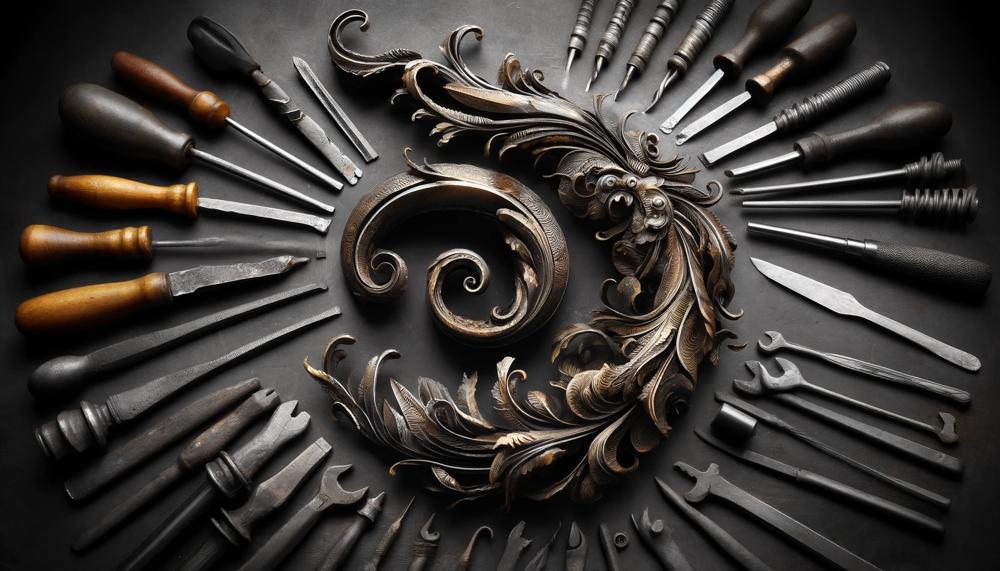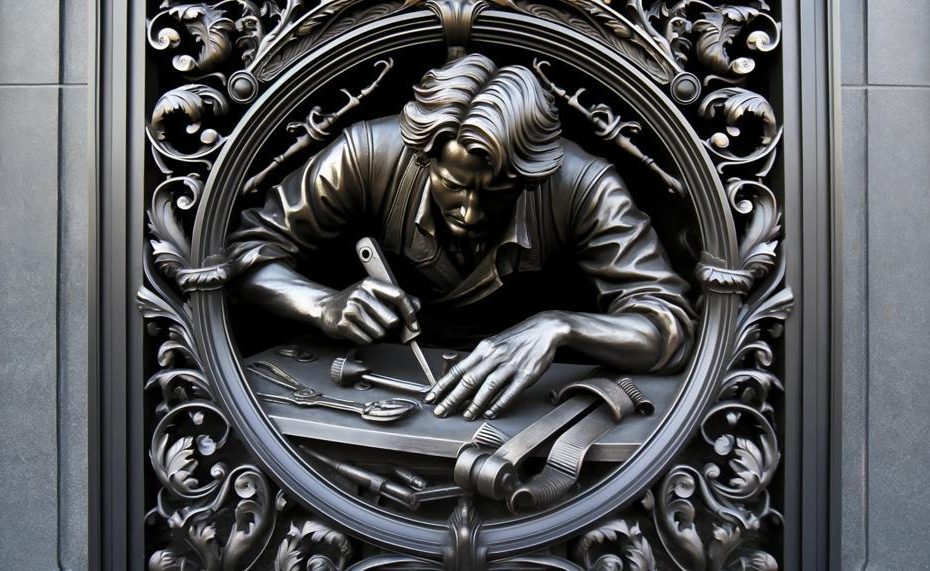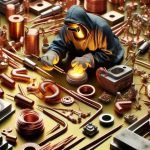Today we start the long, hard, but rewarding process of bringing back the classic beauty of cast iron without having to weld.
This guide will show you different ways to fix wrought iron, whether you’re a do-it-yourself fan, a professional worker, or just someone who likes the way it looks and how long it lasts.
From simple fixes to complex makeovers, we’ll look at ways to do this that don’t involve high heat or special tools like welding, so that a lot of people can do it.
Key insights you’ll gain include:
- Understanding the Basics: Grasp the fundamental aspects of wrought iron and why traditional welding might not always be the go-to solution.
- Preparation Is Key: Learn the importance of proper preparation to ensure a successful repair, including cleaning and rust removal techniques.
- Bonding Alternatives: Discover a variety of adhesive solutions and mechanical fixes that offer strong, durable bonds without the need for welding.
- Finishing Touches: Gain knowledge on how to apply finishing touches that protect and enhance the appearance of wrought iron, ensuring your work lasts for years.
- Maintenance Tips: Uncover essential maintenance tips to prolong the life of your wrought iron, keeping it looking its best with minimal effort.
Embark on this enlightening journey with us as we unlock the secrets to preserving the charm and integrity of wrought iron. Through this guide, you’ll not only save valuable time and resources but also expand your skillset in ways you never thought possible.
Let’s get started.
Contents
Alternative Methods of Repairing Wrought Iron Without Welding
For those looking to repair wrought iron without resorting to welding, several viable options exist.
The choice of method largely depends on the specific damage and the context of the repair. Below is a detailed analysis of alternative methods:
| Method | Description | Best Used For |
|---|---|---|
| Epoxy | A two-part adhesive that bonds metal surfaces. | Small repairs like scratches or holes. |
| Mechanical Fasteners | Utilizing bolts or screws after drilling holes into the iron. | Securing larger, structural pieces. |
| Brazing | Heating the area and filling it with a lower melting point metal. | Strong repairs where appearance is less critical. |
| Metal Bonding Agents | Special adhesives designed for metal. | General purpose bonding, especially for non-structural repairs. |
Epoxy is ideal for small-scale repairs. It’s akin to putting a plaster on a minor wound – not for major surgery, but perfect for a quick, neat fix. When it comes to mechanical fasteners, think of it as stitching up a tear in fabric. It’s robust, sure, but it’s not always the prettiest solution. Brazing is a bit like using a glue gun, only with metal. It’s sturdy and does the trick, especially in less visible areas. Lastly, metal bonding agents are the all-rounders of the repair world – good for various situations but not always the strongest option.

Preparation is key; start with a clean surface and choose your materials wisely. Always follow the manufacturer’s guidelines like a trusty map, ensuring each step is followed with precision. Clamping or weighting the repair area helps the bond set correctly – patience here is your ally.
Remember, each technique has its place. Selecting the right one can be like choosing the right tool for a job – not everything is a nail, so not every problem requires a hammer.
Using Epoxy to Repair Wrought Iron
Absolutely, epoxy can serve as an effective alternative to traditional welding for mending wrought iron. Its appeal lies in the ease of use and accessibility, especially for those who might not have the means or skill to engage in welding. Below, we delve into the reasons why epoxy could be your go-to for wrought iron repairs, ensuring durability and strength in the fix.
- Ease of Application: Unlike welding, which requires a specific skill set and equipment, applying epoxy is straightforward. It involves mixing two components together and applying them to the clean surface of the metal.
- Versatility: Epoxy is adept at filling holes, scratches, and welding thin or thick wrought iron pieces, making it versatile for various repair scenarios.
- Cost-Effectiveness: For DIY enthusiasts or homeowners, epoxy offers a budget-friendly alternative to the often pricey welding process, equipment, and necessary safety gear.
- Preparation and Application: Ensuring a clean surface is paramount for epoxy use. This promotes optimal adhesion, ensuring the repair lasts. The method involves simple steps guided by the manufacturer’s instructions, emphasizing a clean surface and the right mixing ratios.
Let’s take a look at how epoxy compares with other repair methods:
| Repair Method | Suitability | Ease of Use |
| Welding | Structural repairs | Requires expertise |
| Epoxy | Small to medium repairs | User-friendly |
| Mechanical Fasteners | Temporary fixes | Simple |
| Brazing | Joining metals | Some expertise needed |
Using Mechanical Fasteners to Repair Wrought Iron
Repairing wrought iron without resorting to welding offers a blend of traditional craftsmanship and modern ingenuity. Mechanical fasteners are a cornerstone in this approach, providing a robust, reversible, and aesthetically pleasing solution.
Below, we dive into the common types of mechanical fasteners that serve as the backbone for such repairs.
| Type of Fastener | Description | Application |
| Screws | Threaded fasteners typically requiring pre-drilled holes. | Attaching metal components; ideal for smaller repairs or where precision is key. |
| Bolts and Nuts | A bolt is a threaded fastener matched with a nut, providing strong clamping force. | Securing large or structural components; suitable for heavy-duty applications. |
| Rivets | Permanent fasteners that are deformed during installation to hold parts together. | Joining pieces where high strength and a smooth finish on one side are desired. |
| Pins | Unthreaded fasteners that can be slotted or locked into place. | Aligning or securing components with minimal shear forces. |
| Clamps | Temporary or semi-permanent devices that hold components together through tension. | Positioning pieces during repairs or as an adjunct to other fastening methods. |
When opting for mechanical fasteners, the choice hinges on the specifics of the repair task—considerations like the load the joint must bear, the aesthetic outcome, and whether the fix needs to be permanent or adjustable play pivotal roles.
Using Metal Bonding Agents to Repair Wrought Iron
Repairing wrought iron without resorting to the complexities of welding can be ingeniously simple with the right metal bonding agents.
These nifty substances allow for robust, efficient, and aesthetically pleasing repairs, marrying the art of traditional ironwork with the cunning of modern chemistry.
Effective Metal Bonding Agents for Wrought Iron Repairs:
The prime candidates for this task are epoxy resins and certain specialized metal bonding agents designed for ferrous materials.
These agents provide a formidable bond, resistant to weathering, which is crucial for outdoor wrought iron applications.
| Agent Type | Pros | Cons |
| Epoxy Resin | Durable, strong bond, waterproof, fills gaps | Requires precise mixing, limited working time |
| Metal Bonding Adhesives (specific for ferrous metals) | Formulated for metals, resistant to high temperatures and corrosion | May need surface preparation, longer curing times |
| Mechanical Fasteners (as a complementary method) | Reversible, adds physical strength to the joint | Not a standalone solution, requires drilling |
Choosing the Right Agent:
When picking an agent, consider the specific needs of your wrought iron repair. Epoxy resin is a go-to for its versatility and strength, perfect for intricate repairs or when filling is necessary.
Metal-specific adhesives are unbeatable for their tailored composition, ensuring a bond that sympathizes with the metal’s expansion and contraction through the seasons.
Mechanical fasteners, while not bonding agents per se, deserve mention for their role in reinforcing repairs, particularly in structural applications.
Application Tips for Success:
- Surface Preparation: Clean the wrought iron thoroughly, removing rust, paint, and dirt to ensure the best possible adhesion.
- Mixing: If using epoxy, mix precisely according to instructions to achieve the optimal strength.
- Applying: Apply the adhesive evenly, ensuring full coverage for a consistent bond.
- Curing: Allow ample time for the adhesive to cure, resisting the temptation to disturb the repair.
The secret to a lasting repair lies not just in selecting the right adhesive but in the preparation and application.
Tips for Successful Repairs
Repairing wrought iron without welding can seem like a tough nut to crack, but it’s definitely doable with the right approach and a bit of elbow grease. Here’s how you can tackle it:
Choose Your Battle: Select the Right Repair Method
- Epoxy Putty: Great for small cracks or holes. It’s easy to mould and sets hard.
- Mechanical Fasteners: Ideal for joining broken pieces. Think screws, bolts, or clamps.
- Brazing: A step up, using a filler metal for stronger bonds at lower temperatures than welding.
Prep Like a Pro: Surface Preparation Is Key
- Clean: Whip out that wire brush and give the iron a good scrub to remove rust and loose paint.
- Sand: Smooth the area with sandpaper to ensure the repair materials adhere well.
- Rust Converter: Apply it to stop rust in its tracks and prime the surface for painting.
Apply with Care: Doing the Actual Repair
- Epoxy Putty: Mix it according to instructions, apply it to the damaged area, and shape it before it sets.
- Fasteners: Drill holes carefully and bolt or screw the pieces together tightly.
- Brazing: Heat the area and apply the filler metal. It requires skill, so do your homework or seek help if needed.
Finish Strong: Protect Your Repair
- Paint: Once repaired and fully cured, apply a rust-inhibiting paint to match the original colour and protect against future rust.
- Sealant: A clear metal sealant can also help protect the repair from moisture and corrosion.
Mistakes to Dodge:
- Skipping surface prep. It’s tempting, but don’t. It’s the foundation of a durable repair.
- Choosing the wrong adhesive or fastener. Match the repair method to the damage for best results.
Conclusion
Bringing back the beauty of wrought iron without welding is now something that both DIY fans and professionals can do. It’s a mix of traditional skill and modern technology. Along the way, we learn about the basics of preparation, the magic of glue, and the dependability of mechanical fixes in the art of repair without the intense heat of welding. Repairs that are not only long-lasting but also look good are possible with methods like applying glue, using mechanical screws, and metal bonding agents.
The key to success is careful planning, picking the right way to fix things, and using finishes that will last and look good. Whether you’re using glue to fix a small scratch, bolts to secure structural parts, or soldering to make a strong bond, each method has its own benefits and is best suited to a different set of skills and needs.
This method takes the mystery out of the process, making fixing cast iron easier to do. It shows how creative people can be who want to keep the beauty and strength of cast iron, so these structures can continue to decorate our places without the need for people who know how to weld.





